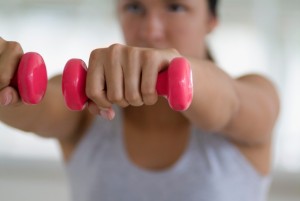Exercise, Eating, and Weight Loss: What You Should Know

There are many different plans you can use to lose weight, but the basic idea behind weight loss is that you need to burn more calories each day than you eat. How do you do this? Public health officials have told us for many years to “eat less and move more.”
Getting more exercise helps you burn calories, and eating less means you are taking in fewer calories. Together, these can lead to weight loss. However, according to the results of a recent study, the “eat less, move more” idea might not always lead to success.
The Research
The study asked a small number of people to walk briskly on a treadmill until they were told their workout was over. They were also asked to guess the total number of calories that they had burned during their workout. Then, they were given access to a buffet and asked to eat that same number of calories. They did not know exactly how much they had burned or how many calories they ate.
In another, similar study, instead of walking, people were asked to do moderate or high intensity exercise (running on a treadmill) for a short amount of time. They were then asked to guess the number of calories they had burned and eat that same number of calories at a buffet.
The researchers were looking to answer 3 questions:
- Could people correctly guess the number of calories they burned during their workout?
- Did the number of calories people ate after the workout equal the number of calories people thought they burned?
- How did the number of calories that people ate after a workout compare to the number of calories they actually burned?
The Results
For the study where people walked on the treadmill, the results showed that:
- People guessed that they had burned 3 to 4 times more calories than they had actually burned.
- The number of calories they ate was less than they thought they had burned, but much more than they had actually burned.
For the study where people ran on the treadmill, the results showed that:
- When people did moderate intensity exercise, they burned more calories than they thought they had.
- When they did high intensity exercise, the number of calories they thought they burned was very close to the real number.
- For both the moderate and high intensity exercisers, people ate more calories than they had actually burned.
What Do These Results Mean For You?
The most important lesson to be learned from this study is that many people think they are burning more calories during their workout than they are actually burning. This is true no matter how hard the workout is.
The problem with this is that it can lead people to eat more calories after the workout than they burned during the workout. The result is that their weight loss could slow down.
So, while it’s important for you to stay active, it’s also vital that you don’t overdo it with the snacks, or you might undo all your hard work!
The Take Home Points
 They key to weight loss is to burn more calories than you eat each day.
They key to weight loss is to burn more calories than you eat each day.
- Many people over-estimate the number of calories they burn during their workouts.
- They also under-estimate the number of calories in many of the foods they eat.
- You should get as much exercise as you can, but remember, just because you are active, this doesn’t mean that you can eat whatever you want.
- Be sure to work with a healthcare provider you trust to make an eating and exercise plan that allows you to lose weight while keeping your metabolism healthy.
Source: http://www.montrealgazette.com/touch/story.html?id=9757847

